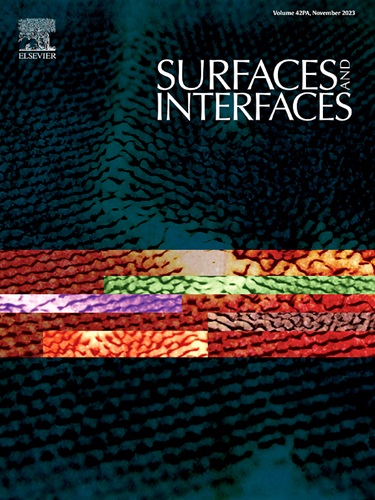多孔β -环糊精聚合物混合基质膜的制备及其去除苯并三唑的研究
IF 6.3
2区 材料科学
Q2 CHEMISTRY, PHYSICAL
引用次数: 0
摘要
将粉状材料制备成膜是解决纳米粉体吸附剂易损失的有效手段之一。在本研究中,我们首先探索了多孔β -环糊精聚合物(P - CDP)粉末对苯并三唑(BTA)的去除潜力,发现P - CDP粉末对BTA的去除效率很高,并研究了P - CDP粉末对BTA的去除机理,其中P - CDP粉末的离子C−F键与BTA的N−H键化学结合,形成新的共价N−F键。此外,π-π相互作用和氢键对BTA分子也起着重要作用。为解决粉状材料不易回收、易对水体造成二次污染的问题,将P−CDP粉末集成到聚丙烯腈(PAN)膜中,制备了一种新型的吸附混合基质膜。采用简单的相变策略制备了P−CDP/PAN混合基质膜。对所制膜的理化性质进行了表征,并比较了P−CDP粉末的不同负载率。实验结果表明,最佳P−CDP/PAN膜吸附BTA的饱和时间最快(10 min), BTA的最高吸附量为337 mg·g−1。同时,P−CDP/PAN膜具有亲水性,具有83 L·m−2·h−1·bar−1的高透水性。此外,最佳P−CDP/PAN膜在动态系统中去除BTA具有良好的应用前景。此外,P−CDP/PAN膜在多次循环中表现出出色的再生效率和可重复使用性,与传统粉状吸附剂相比,其相分离后处理程序也简化了。本研究为新型有机污染物吸附膜的制备提供了新思路。本文章由计算机程序翻译,如有差异,请以英文原文为准。

Fabrication of porous β−cyclodextrin polymer mixed matrix membranes for benzotriazole removal from aqueous solution
Preparation of powdered materials into membrane is one of the effective means to address the susceptibility of nanopowder adsorbent materials to loss. In this study, we first explored the potential of porous β−cyclodetrin polymer (P−CDP) powders in the removal of benzotraizole (BTA), and found that P−CDP powders have high efficiency in removing BTA, and the mechanism of BTA removal on P−CDP powders was investigated, in which the ionic C−F bonding of P−CDP powders and N−H bonding of BTA chemical combination and create a new covalent N−F bonding. Furthermore, the π-π interactions and hydrogen bonds also played an important role on BTA molecules. In order to solve the problems that powdered materials are not easy to recycle and easy to cause secondary pollution of water bodies, a innovative adsorptive mixed matrix membranes were prepared via integration P−CDP powders into polyacrylonitrile (PAN) membranes. The P−CDP/PAN mixed matrix membranes were fabricated by a simple phase inversion strategy. The physicochemical properties of the obtained membranes were characterized and the different loading rates of P−CDP powders were compared. Experimental results showed that the optimal P−CDP/PAN membranes had the fastest saturation time for BTA adsorption (10 min) and the highest BTA adsorption capacity of 337 mg·g−1. Meanwhile, the P−CDP/PAN membranes exhibited the hydrophilic nature with a high water permeance of 83 L·m−2·h−1·bar−1. In addition, the optimal P−CDP/PAN membranes displayed promising application in dynamic system for removing BTA. Moreover, the P−CDP/PAN membranes demonstrated outstanding regeneration efficiency and reusability over multiple cycles, coupled with simplified post-treatment procedures for phase separation compared to conventional powdered adsorbents. This study provides a novel strategy in fabricating adsorptive membranes for emerging organic contaminants removal.
求助全文
通过发布文献求助,成功后即可免费获取论文全文。
去求助
来源期刊

Surfaces and Interfaces
Chemistry-General Chemistry
CiteScore
8.50
自引率
6.50%
发文量
753
审稿时长
35 days
期刊介绍:
The aim of the journal is to provide a respectful outlet for ''sound science'' papers in all research areas on surfaces and interfaces. We define sound science papers as papers that describe new and well-executed research, but that do not necessarily provide brand new insights or are merely a description of research results.
Surfaces and Interfaces publishes research papers in all fields of surface science which may not always find the right home on first submission to our Elsevier sister journals (Applied Surface, Surface and Coatings Technology, Thin Solid Films)
 求助内容:
求助内容: 应助结果提醒方式:
应助结果提醒方式:


